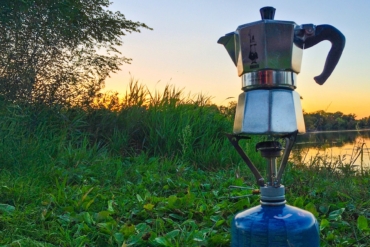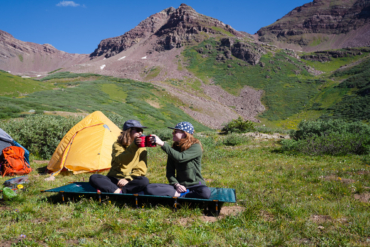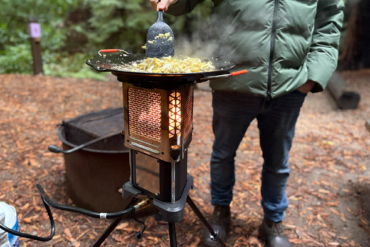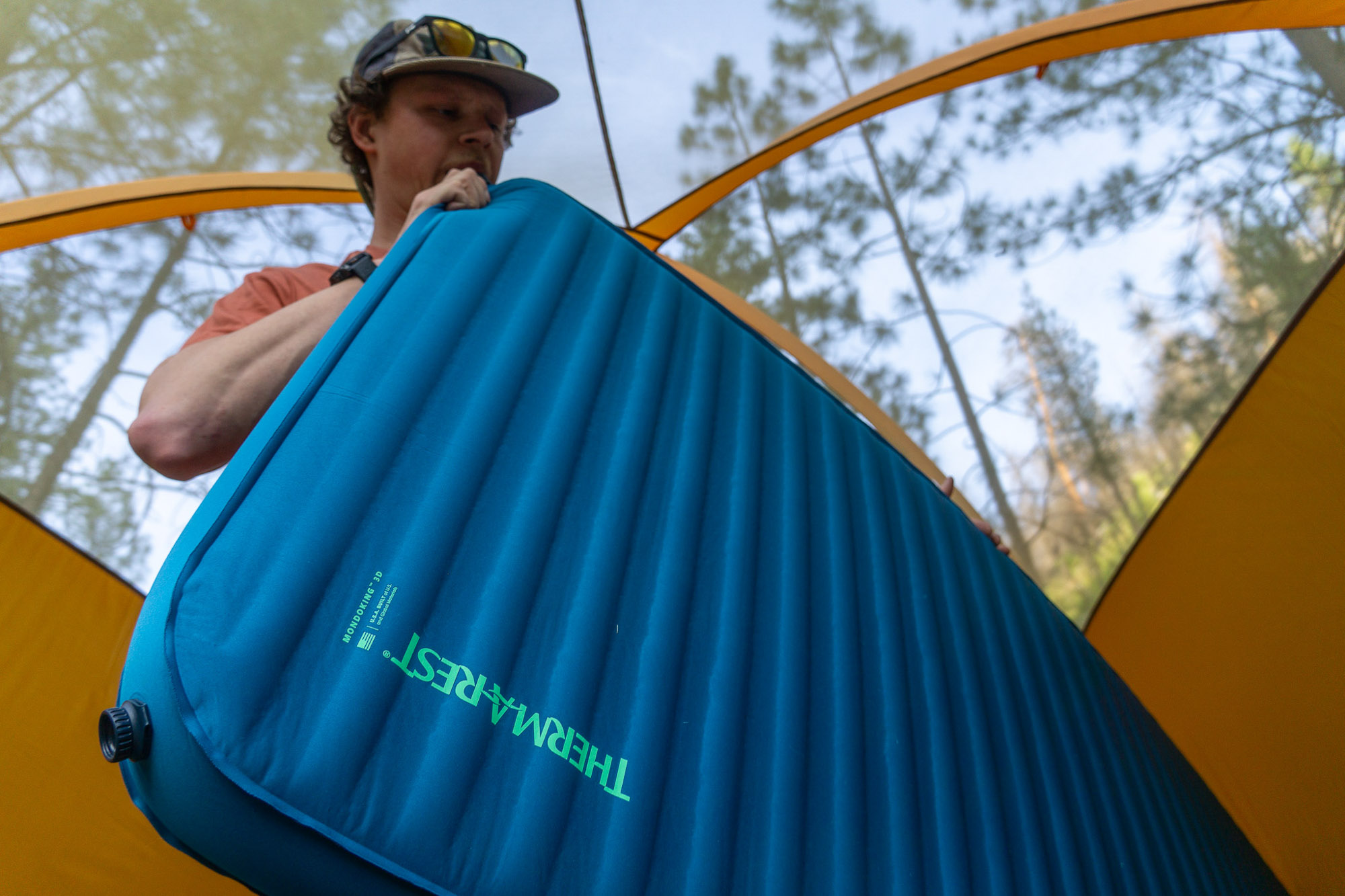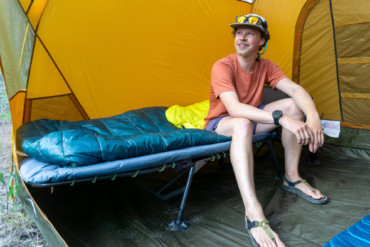Camping is more fun with a dog. Grab a feature-stuffed Midori tent from Eureka! and spend the night snoozing under the stars. You’ll make memories that will last a lifetime camping with a dog.

There’s nothing better than spending the night camped out under the stars with your furry friend. But the wrong equipment or lack of preparation can quickly turn a memorable weekend into a disastrous outing. To ensure you both have a fun time, here are 10 tips and tricks for camping with a dog.
1. Choose the Right Tent
If your dog is anything like my yellow lab, Baylor, he will take up a lot of space. I always consider my dog a person when camping and choose a tent accordingly. Sure, we could squeeze into a one-person tent, but for maximum comfort, I recommend going bigger. The Eureka! two-person Midori is a great match for you and Fido. The “Smart Space” design provides extra room to help you both get a good night’s sleep. And at just $159.95, you can get a lightweight tent that won’t break the bank.

2. Practice at Home
It may seem silly, but setting up the tent at home is useful for both you and your dog. You’ll get a chance to work out any setup kinks, and your pup will get comfortable with this new home away from home.
Practice getting in and out, spend an hour inside together, and decide where you’ll each sleep. The double doors on the Midori are ideal for camping with a dog. Your pup will have his own “doggy door” and won’t have to climb over you when he needs out.
3. Keeping Anxious Dogs Happy
Most dogs love camping and will quickly acclimate to the tent life. If your pup is still nervous after setting up at home and completing the basic tent acclimation – we’ve heard accounts of digging, barking, or frantically trying to chew through tent walls – here are a few additional tips.
The best thing I ever taught my dog was a “go to bed” command. Starting when he was just an 8-week-old ball of fluff, he was trained to get on his bed and not get up until given the OK. After repeated and consistent use, I could point at any bed, towel, rug, sleeping bag, or pile of clothes, say “go to bed,” and he would lie there until released. This is especially useful when heading into the tent. It keeps dogs from pacing around or acting crazy once the tent door is zipped. Whether at home or in the wilds, start practicing “go to bed.” Trust me: You’ll both be more sane and comfortable.
If, however, you want to head out before this command is refined, there are a few other tips to protect gear. First, trim your dog’s nails before heading out. It’s a small step that helps protect the tent floor and your sleeping pad from sharp nails. For further protection, pack an extra tarp or blanket for the inside of your tent. Place your sleeping pad under it and put the sleeping bags on top.
If your dog still will not relax with you in the tent, he may feel better sleeping in the vestibule or in a safe space away from the tent. Depending on the presence of hazards and predators, it may or may not be advisable to tether your pup to a nearby tree.
And at the end of the day, not all dogs are meant to go camping. Remember the goal is a fun time for both humans and canines.
4. Check the Rules
Campgrounds often have restrictions on the number of dogs per campsite. And some even have rules surrounding dog size or breed. Check online or call ahead to make sure your canine will be welcome. Once at the campground, follow the rules and be considerate of your camp neighbors. Keep your dog on a leash and don’t leave him unattended at the campsite.
If planning a trip into the backcountry, you’ll still want to check for restrictions and regulations. In general, national parks do not allow dogs, while national forests and Bureau of Land Management (BLM) lands are very dog-friendly. You’ll still need a leash for the trail, and pay extra attention to prevent unwanted wildlife interactions.
5. Bring Plenty of Water
Water isn’t so much of a concern when spending the weekend at a campground. But if you plan to wild camp in a national forest or on BLM land, bringing enough water is critical. General guidelines recommend 1 ounce per pound, every hour. Plan to carry in enough water for you both, or choose a route and location with plenty of fresh water.
6. Pack Pup Supplies
Packing the right supplies can make or break the camp adventure. A leash, kibble, and water bowl are requisite. A dog sleeping bag, a collar light, canine first-aid kit, and plenty of treats are highly recommended. While these extra supplies could make a small tent feel cramped, they’ll easily fit in the large vestibules of the Midori. This keeps gear easily accessible and protected from the weather while maintaining the maximum amount of interior space.
7. Stay Organized
Whether camping with a dog or not, there’s nothing more annoying than digging through an unorganized gear pile in search of the one thing you need. For this, I love tent pockets. Dedicate one to stashing treats, a leash, and a flashlight (for those midnight potty breaks). Because the Midori tent has four pockets, you’ll have three left to organize the rest of your small gear items. And then you can fill the gear loft with anything you don’t want your dog to access. This is especially useful for keeping clean clothes away from muddy or wet puppy paws.

8. Watch Out for Hazards
Depending on the location and time of year, ticks are a major concern – for you and your pup. After hiking, give your dog a once-over for ticks and consider using preventive medications to fight off both ticks and fleas.
You’ll also need to be aware of regional hazards. This includes fast-moving water, steep cliffs, porcupines, poisonous snakes, and noxious plants. Check with your vet and call the local ranger to get any tips on local hazards. And when you’re packing up, don’t forget Fido’s first-aid kit. A minor scratch can turn into a big problem if unprepared.
9. Check the Weather
Sure, the Midori is built to withstand wind, rain, and unpredictable weather, but it helps to know what you’re getting into before heading out. Depending on the breed, your dog may need an extra jacket or blanket for staying warm at night. And if rain is in the forecast, it helps to have a towel for drying off before heading to bed at night.
Between Eureka!‘s weather-tough construction and patented high-low ventilation design, you’ll stay dry and comfortable no matter what Mother Nature throws at you. Pack a few extras for your pup, and you’ll both enjoy getting outdoors all year long.

10. Pick Up After Your Dog
There’s no way to get around this one. Keep the beautiful spaces we love clean and open to our furry friends. If camping in the backcountry, treat their poo just like yours: Bury it away from trails and water sources. When staying in a campground or hiking on a heavily used trail, be sure to come prepared. Bring baggies, pick it up, and pack it out.
Now that you know what it takes to start camping with a dog, it’s time to plan the adventure. Make a campground reservation or pack up for a backpacking weekend. And whether heading into the backcountry or enjoying a car camping excursion, the Midori is a tent built for camping with a dog. You and Fido will love the spacious interior, double-door entry, and easy setup.
Most of all, it’s the perfect home away from home for all your outdoor adventures.
This post is sponsored by Eureka! For more information on Eureka! and the two-person Midori, click here.



